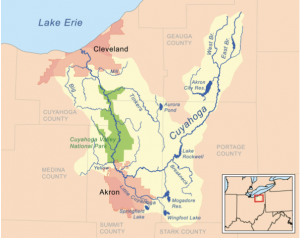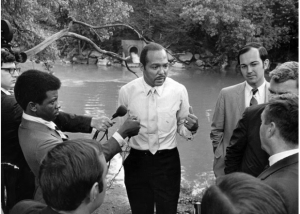By: Rachel Musetti, General Sustainability Intern, Office of Sustainability Initiatives

The Cuyahoga River begins in northeastern Geauga County, Ohio and continues into Akron, running both south and west, before turning back north to Cleveland on Lake Erie. In the middle of the twentieth century, the Cuyahoga River was notoriously one of the most polluted rivers in the country, largely as a result of Cleveland’s industrial history. The river was a free home to the pollution created from the steel mills and factories and had caught fire over a dozen times prior to the 1970s, killing five people and costing the government millions in damages (Grant 2020). When the Cuyahoga River caught fire once again on June 22, 1969, the incident itself was not out of the ordinary, but this time, the leadership made all the difference.
Carl B. Stokes was the first Black man to be elected mayor of a major United States city, serving from 1967 to 1971 (Rubin 2019). During his term, Stokes worked to address water quality concerns at a local level. The year before the conflagration, Cleveland voters passed a $100 million bond issue for sewer upgrades. But Stokes argued that the river ran through too many places out of his jurisdiction to protect it with only local measures. Cuyahoga River, he argued, deserved national attention and federal funding.

The day following the fire, Mayor Stokes turned to the press and launched his “Pollution Tour,” through which he brought national attention to the local fire (Cuyahoga Valley National Park 2020). Stokes led reporters to the location of the fire, an industrial site, and the sewers that contributed to the pollution of the river. The following year, he testified before the United States Senate on behalf of the US Conference of Mayors, arguing for federal funding for clean water. National attention and Mayor Stokes’ urging continued, and eventually, in 1972, Congress passed the Clean Water Act, which created quality standards for surface water and regulates discharges of pollutants (Environmental Protection Agency 2020).
Although Stokes was labeled an environmentalist for his efforts to clean and strengthen regulation of water quality, his ideology aligned more with what we now call environmental justice, as he frequently pleaded for more attention to be given to the urban environment and those within it. His beliefs were ahead of his time – it wasn’t until the 1980s that the environmental justice movement took off, focusing on how poor environmental conditions affect minority groups and low-income communities more than others (Cuyahoga Valley National Park 2020). Thanks to Stokes not only did the nation see the passage of the Clean Water Act but widespread attention was also given to human-nature relations.
Work Cited:
Cuyahoga Valley National Park. (2020, December 08). Carl B. Stokes and the 1969 River Fire. Retrieved February 05, 2021, from https://www.nps.gov/articles/carl-stokes-and-the-river-fire.htm
Environmental Protection Agency. (2020, September 09). Clean Water Act. Retrieved February 05, 2021, from https://www.epa.gov/laws-regulations/summary-clean-water-act
Grant, J. (2020, April 21). How a Burning River Helped Create the Clean Water Act. Retrieved February 05, 2021, from https://www.alleghenyfront.org/how-a-burning-river-helped-create-the-clean-water-act/
Rubin, R. (2019, July 02). Oral histories of the 1969 Cuyahoga River Fire. Retrieved February 05, 2021, from https://beltmag.com/cuyahoga -river-fire-1969/
